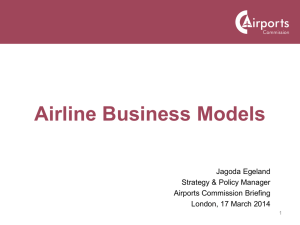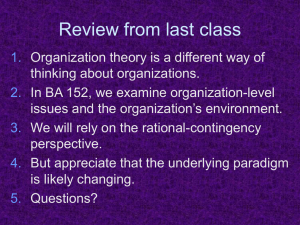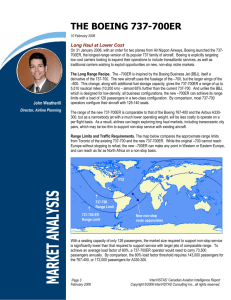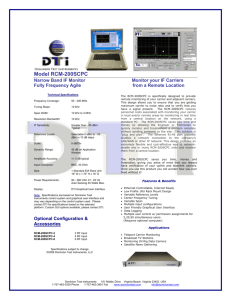effect of economic crisis on the changes of low
advertisement
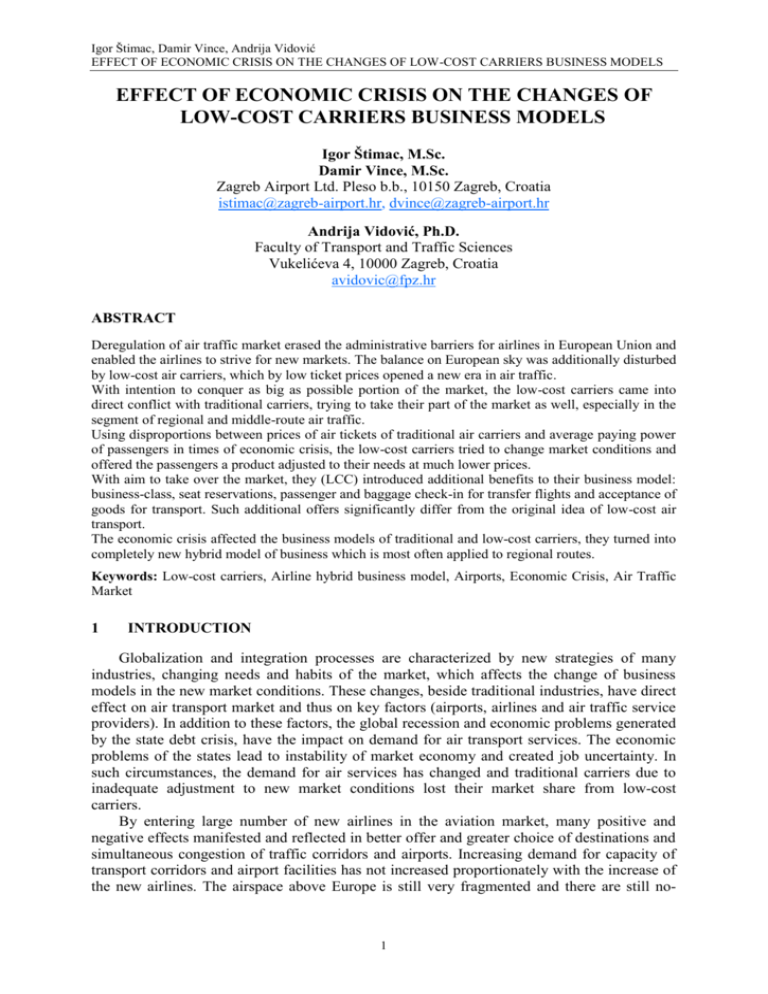
Igor Štimac, Damir Vince, Andrija Vidović EFFECT OF ECONOMIC CRISIS ON THE CHANGES OF LOW-COST CARRIERS BUSINESS MODELS EFFECT OF ECONOMIC CRISIS ON THE CHANGES OF LOW-COST CARRIERS BUSINESS MODELS Igor Štimac, M.Sc. Damir Vince, M.Sc. Zagreb Airport Ltd. Pleso b.b., 10150 Zagreb, Croatia istimac@zagreb-airport.hr, dvince@zagreb-airport.hr Andrija Vidović, Ph.D. Faculty of Transport and Traffic Sciences Vukelićeva 4, 10000 Zagreb, Croatia avidovic@fpz.hr ABSTRACT Deregulation of air traffic market erased the administrative barriers for airlines in European Union and enabled the airlines to strive for new markets. The balance on European sky was additionally disturbed by low-cost air carriers, which by low ticket prices opened a new era in air traffic. With intention to conquer as big as possible portion of the market, the low-cost carriers came into direct conflict with traditional carriers, trying to take their part of the market as well, especially in the segment of regional and middle-route air traffic. Using disproportions between prices of air tickets of traditional air carriers and average paying power of passengers in times of economic crisis, the low-cost carriers tried to change market conditions and offered the passengers a product adjusted to their needs at much lower prices. With aim to take over the market, they (LCC) introduced additional benefits to their business model: business-class, seat reservations, passenger and baggage check-in for transfer flights and acceptance of goods for transport. Such additional offers significantly differ from the original idea of low-cost air transport. The economic crisis affected the business models of traditional and low-cost carriers, they turned into completely new hybrid model of business which is most often applied to regional routes. Keywords: Low-cost carriers, Airline hybrid business model, Airports, Economic Crisis, Air Traffic Market 1 INTRODUCTION Globalization and integration processes are characterized by new strategies of many industries, changing needs and habits of the market, which affects the change of business models in the new market conditions. These changes, beside traditional industries, have direct effect on air transport market and thus on key factors (airports, airlines and air traffic service providers). In addition to these factors, the global recession and economic problems generated by the state debt crisis, have the impact on demand for air transport services. The economic problems of the states lead to instability of market economy and created job uncertainty. In such circumstances, the demand for air services has changed and traditional carriers due to inadequate adjustment to new market conditions lost their market share from low-cost carriers. By entering large number of new airlines in the aviation market, many positive and negative effects manifested and reflected in better offer and greater choice of destinations and simultaneous congestion of traffic corridors and airports. Increasing demand for capacity of transport corridors and airport facilities has not increased proportionately with the increase of the new airlines. The airspace above Europe is still very fragmented and there are still no- 1 Igor Štimac, Damir Vince, Andrija Vidović EFFECT OF ECONOMIC CRISIS ON THE CHANGES OF LOW-COST CARRIERS BUSINESS MODELS flight zones that prevent the shortest routes between destinations. EUROCONTROL has the role of air traffic management coordinator in order to achieve maximum throughput with minimum delay without deviation from the schedule. The other bottleneck for better organization of air transport is the capacity of the airports. Considering the fact that most airports have problems with available space for expansion of infrastructure, or the inability to solve some environmental problems, they use pricing policies to regulate demand of their services. High cost of airport services is unacceptable for low-cost carriers and they transfer their operations towards secondary airports. Liberalization of air transport and signing of multilateral agreements (Open Sky, ECAA Single Sky) contributed to the removal of administrative barriers that have been blocking the development of air transport. The flying rights are determined by bilateral agreements and make impossible for all airlines to fly under the same conditions and so disabled their penetration to some markets. The effort of every air carrier is to ensure a sustainable competitiveness and profitability, and these external factors, to which air carriers have no direct influence, force them to seek new business models and tactics of penetration into new markets. 2 THE BUSINESS POLICY OF LOW-COST CARRIERS In the market it is often wrongly used the term of low-cost carrier in way to describe any airline which offers low air fares and limited service. An example is a regional airline that operates on short-haul routes without serving passengers during flight or an airline that offers full service at reduced price, and both of those airlines are considered as low-cost airlines. There is no unified definition of low-cost carrier (LCC); moreover, there is no single term that refers to such companies because they often use terms such as low-fare airlines, low-cost airlines and no-frill airlines. However, there exists a unique understanding and public perception what LCC is because it comes mainly from the features of utilized business model. Although the business models of the individual airlines may vary, there are many common characteristics that can generate overall picture what low-cost business model is and what low-cost carriers represent. The main characteristic of this business model is usage of aircraft with single passenger class and operating with only one model of aircraft (uniform fleet). In the past, low-cost carriers used to operate with older types of aircraft, such as the McDonnell Douglas DC-9 and the first models of Boeing's 737. Since year 2000, the low-cost carrier fleet is mostly made up of newer aircraft with greater fuel efficiency, such as the Airbus A319/320 aircraft or new Boeing 737 series aircraft. This policy has significantly reduced the operating costs of aircraft maintenance and personnel training. Table 1 shows an overview of the number of aircraft and number of served destinations for the largest European network and low-cost carriers. 2 Igor Štimac, Damir Vince, Andrija Vidović EFFECT OF ECONOMIC CRISIS ON THE CHANGES OF LOW-COST CARRIERS BUSINESS MODELS Table 1: Fleet and destinations of the largest low-cost and network carriers in Europe Air carrier Aircraft type Number of AC + ordered aircraft Destinations Network carrier Lufthansa (1950.) 12 247 + 83 202 Austrian Airlines (1957.) 6 33 117 Air France (1933.) 13 253 + 33 183 KLM (1920.) 13 114 + 16 182 Low-cost carrier RyanAir (1985.) 1 254 + 38 161 German Wings (1997.) 1 30 + 8 70 easyJet (1995.) 3 173 + 58 129 Wizz Air (2003.) 1 34 + 98 66 Norwegian Air Shuttle (1993.) 3 46+15 166 Source: Air Fleet; http://www.airfleets.net/home/ and official airlines websites Low-cost carriers’ aircraft often operate with minimal additional equipment, and by that reduce maintenance costs and the weight of the aircraft and that result in reduced fuel consumption. They do not offer seat reservations, hoping it will encourage passengers to early and rapid loading, and by that reduce retention time of aircraft on the ground and increase the number of daily rotations. The system of ticket price is based on simplicity, such as the payment of one-way tickets for half the price of return ticket. Air fares are increased progressively closer to date of flight and in accordance with the aircraft occupancy. Time for handling at airports is considerably shorter compared with handling time for network operators. Another characteristic of the low-cost model is that there are no transfer passengers, i.e., the baggage are not transferred automatically from one flight to another, even if both flights are performed by the same airline. Such a policy leads to savings and encourages passengers to fly direct flights. Considering the low price of airline tickets, in many cases, low-cost carriers generate additional revenues from various activities, such as food and beverage offer “a la carte” where the staffs gets a commission on sold products. Some low-cost carriers charge a fee for the use of pillows, blankets and hand baggage. In many cases the savings are achieved because employees are responsible for performing several different tasks. In most low-cost carriers cabin crew, besides their main job, cleans aircraft or work as agents at the airport gates in the purpose of reducing the additional costs for use of airport staff. Fuel is also an important item when it comes to savings. Southwest Airlines is known for savings of the fuel cost by negotiating the fuel quantity and its price by using the so-called “hedging”. The savings can be achieved by avoiding the use of gates that include air bridge. Table 2 shows the most important features of low-cost business model by which they achieve the greatest differences in operating costs in relation to network carriers. 3 Igor Štimac, Damir Vince, Andrija Vidović EFFECT OF ECONOMIC CRISIS ON THE CHANGES OF LOW-COST CARRIERS BUSINESS MODELS Table 2: Comparison of low-cost and network carriers Low-cost carrier Network carrier Mostly use secondary regional airports Use primary airports and international HUB airports Fast aircraft handling (about 25 min) Direct point-to-point flights, there is no transfer of passengers, short-haul routes Slow aircraft handling caused by congestion at the HUB airports Better utilization of the fleet A mixture of long-haul, mediumhaul and short-haul flight with transfers Lower complexity, higher capacity utilization More types of aircraft with lower seating density (greater distance between seats) Cheaper aircraft financing, lower costs of maintenance and employee training, higher capacity utilization Uniform fleet (one model of aircraft) Advantage for LCC Lower airport fees, faster aircraft handling, fewer delays due to congestion and traffic control Direct communication with Most tickets sold via travel Lower distribution costs, easier to user via the Internet or agencies purchase tickets customer centre No additional charge for Entertainment programs, separate catering handling (they registration of business passengers, Lower secondary costs, less complexity, don’t use handling at other VIP lounges, a paper ticket, additional revenue airport, only) business class, free catering Stimulation for employees High fixed salaries (variable Higher employee productivity (variable income up to 40%) income less than 10%) Source: European Low Fares Airline Association, Liberalisation of European Air Transport: The Benefits of Low Fares Airlines to Consumers, Airports, Regions and the Environment, Belgium, 2004 Beside increased number of seats in the aircraft, important elements for achieving additional profit are efficiency of the fleet and its optimization. Table 3 presents an example of seat configuration of the Airbus A319 aircraft for few low-cost and network carriers. Table 3: Seating configuration of network and low-cost carriers at the example of A319 aircraft Air carrier Croatia Airlines Aircraft Seats per classes aircraft Network carrier 2 132 Rows per aircraft Distance between the seats 22 81,1 cm Lufthansa 2 132 22 81,1 cm TAP Portugal 2 132 22 81,1 cm Air France 2 132 22 81,1 cm Low-cost carrier 1 150 1 156 1 150 25 26 26 76,2 cm 73,6 cm 76,2 cm German Wings easyJet airberlin Low-cost carriers have an average daily utilization of aircraft from 10 to 13 block hours, while the aircraft utilization for network operators is around 8 block hours. The main reason for such high aircraft utilization lies in the fact that low-cost carriers are not forced to use the main HUB-s. Network carriers have to synchronize their flights due to the congestion and the connection to transfer flights at major airports, which reduces the time of daily utilization. Another way to increase the efficiency of the rotation during the day is use of secondary airports where handling time for low-cost carriers lasts from 20 to 25 minutes. Such a short period for aircraft handling is the result of short cleaning time, faster loading (no seat reservation), and staff stimulation for greater productivity. The result is that the fixed annual 4 Igor Štimac, Damir Vince, Andrija Vidović EFFECT OF ECONOMIC CRISIS ON THE CHANGES OF LOW-COST CARRIERS BUSINESS MODELS costs per operation, such as depreciation or leasing costs, maintenance and insurance, are much lower. 3 CLASSIFICATION OF LOW-COST CARRIERS The low-cost carrier concept originated from United States, after which in the early nineties of last century it spread through Europe and the rest of the world. The first and today’s largest European low-cost carriers were Ryanair and Easyjet. After an initial operation by based low-cost model, low-cost carriers have created specific business systems, which today can be divided into three types of low-cost business models1: The original low-cost carriers (like Ryanair) are based on the following business strategy: - mostly use secondary airports, - no free services to passengers, - the tickets can be purchased online or through call centre, - the high seat density, - the minimum costs for aircraft handling, - no expansion of network to long-haul flights, - high utilization of aircraft on point-to-point flights, - one type of aircraft, - smaller administration and fewer staff/offices – lower total costs, - high productivity and low-costs of the crew. Low-cost carriers that deviate from the base model (such as Easyjet): - mainly use primary airports, - sometimes offer better passenger services at higher prices. A mixed model between low-cost carrier and charter carrier (such as Air Berlin): - mainly use primary airports, - fly by charter and low-cost model – sometimes on the same flight, - sometimes offer better passenger services. In addition to these three categories of low-cost model may be added another. These are carriers that offer low prices on certain routes while at the same time do not have the structure of low-cost carrier. From the mentioned classification it is clear that there is no longer a clear division between low-cost, charter and network carriers. Passengers are looking for low prices and buy tickets from any model, if it meets their needs. 4 IMPACT ON THE ECONOMIC CRISIS IN CREATION OF HYBRID AIR CARRIERS Aviation market is a very dynamic market, which is confirmed by rapid development of new air carriers which want to create good business climate in global aviation market. A large number of such companies, due to strong competition, are trying to focus its business in a way that they use only what they consider best from each business models. In addition to the above mentioned facts, aviation market is very unstable due to strong impact of global economic crisis. The consequences of reduced demand for air transport can be seen with the most traditional air carriers due to stronger competition and expansion of low-cost carriers, the fleet 1 European Low Fares Airline Association, Liberalisation of European Air Transport: The Benefits of Low Fares Airlines to Consumers, Airports, Regions and the Environment, Belgium, 2004 5 Igor Štimac, Damir Vince, Andrija Vidović EFFECT OF ECONOMIC CRISIS ON THE CHANGES OF LOW-COST CARRIERS BUSINESS MODELS of which is several times bigger than the ones found with the most traditional carriers. The additional competition to traditional carriers is also found in other forms of transportation. Primarily, this refers to the fast trains which, with great comfort, cheap ticket prices and duration of travel, take passengers away from air transport, especially in the short and medium-sized travel. The recession and the orientation of companies towards rational operations, which include eliminating unnecessary costs, determined the changes in business travelling. Business class passengers, who were the biggest revenue generators of traditional carriers before economic crisis, focused their need for business trips on low-cost carriers or fast trains. Faced with new developments on the market, some airlines have adopted their current business model in a way that they combine the best features of both traditional and low-cost carrier business models in one. The global economic crisis has mainly affected business of network and charter carriers, which began to lose passengers due to higher fares. In order to survive on these markets, network airlines also began to offer cheaper airline tickets. The initial disorientation of network and charter carriers caused by a sudden drop in passenger traffic has readily been met by low-cost carriers, who took over a significant number of travellers from network carriers with their prices, those passengers who have previously used the services of not only network and charter carriers, but also of other transport sectors. To attract more passengers from network air carriers, low-cost carriers have also started to modify their business model. The result is that some of the previously typical representatives of the base low-cost carrier model have now created a new model in the aviation market - a hybrid model. A hybrid air carrier within its model uses elements of other business models considered important for the better development of its own business models. Table 4 shows the characteristics of creation of hybrid model between network and low-cost carrier airline. Table 4: Characteristics of a hybrid model based on low-cost and network carriers On Low-cost carrier it was added seats reservation Free food and drink audio and video entertainment loyalty program (FF) transfer flights Registration of passengers to their final destination different systems fares use travel agencies to sell airline tickets cooperation with travel agencies Hybrid Air Carrier On network carrier it was added: increased flexibility of air fares reduced volume of catering reduced aircraft handling time in less than 30 minutes use of aggressive marketing policies price determination of the flight sectors direct sales of air tickets multiple routes on “point to point” basis Since the original strategy of the airline business and its base model, it can be defined into five types of different hybrid models: 1. The hybrid model between charter and low-cost carriers An example presenting the hybrid model as a mixture of charter and low-cost carrier: this business model can be found with Air Berlin carrier. This charter airline modifies its business model by switching to a hybrid model so as to reduce dependence on the German tour operators. In the mid- nineties, the charter company Air Berlin began selling its seats only on charter flights, which made it the largest company for the carriage of tourists in Germany. In order to keep its independence at the seasonality influence of certain destinations, Air Berlin flights unveiled a flight program called “City Shuttle”, which worked on the principle of low-cost carrier 6 Igor Štimac, Damir Vince, Andrija Vidović EFFECT OF ECONOMIC CRISIS ON THE CHANGES OF LOW-COST CARRIERS BUSINESS MODELS 2. 3. business model. With this model Air Berlin was connecting the various airports in Germany with the key destinations in Europe such as London, Rome, Milan, Vienna and Zurich. Unlike other low-cost carriers, Air Berlin offers transfer flights from its base airports in Berlin, Düsseldorf, Nuremberg and Palma de Mallorca, and it also offers a full range of services, including meals and drinks during the flight, newspaper distribution, assigned seats and loyalty programs. The hybrid model between a low-cost carrier and a network carrier An example of a hybrid model between the low-cost carrier and the network carrier can easily be found in the Air Baltic airline company, founded in 1995 by Scandinavian Airlines (SAS) and the State of Lithuania. In its fleet Air Baltic uses multiple models of aircraft, which is not a common feature of the original low-cost carrier model, from the Dash8-Q400, via Boeing B737 to Boeing B757. This hybrid model took over from network airlines model fast and reliable connections, with one of the best business class regarding quality and interior design. They also took over the model of registration of passengers to their final destination, a strong network of partners, usage of business lounges at airports and loyalty program (FF). From the low-cost carrier model, Air Baltic took the cheapest one-way tickets, payment for food and drinks on board and the staff stimulation, which ultimately resulted in 40% lower operating costs. Another example of a hybrid airline, which is a combination of network and low-cost carrier model, is the carrier Aer Lingus. As a member of the OneWorld group, this former Irish national carrier offers a full service product on its flights from Dublin and Shannon to Europe and the transatlantic flights to the United States. Aer Lingus base its business on low-cost business model that combines both short range flights and long range flights with two passenger’s classes to North America, while distributing free food and drinks. Business passengers on low-cost carrier flights Although most low-cost carriers rely on leisure passengers who travel in their free time, the interest of business travellers on low-cost flights has been growing recently. According to reports from easyJet, the ratio of business and “leisure” passengers on board, on some specific routes is 50/50 %. In 2000 McWhirter came to the realization that 40% - 80% of passengers on the aircraft were actually business travellers. The first low-cost carrier which separated from original low-cost model strategy, like Southwest had regarding the structure of passengers, is the airline called Debonair, which introduced splitting of cabin and formed class of passengers inside the aircraft. Profile of business travellers which are use low-cost carriers is different, and depends on size of their company, booking and sales systems that those firms use, the importance of ticket price and use of business lounges. Survey showed that business passengers mostly look up the ticket price i.e., services value for money, market strength of the airline, flexibility and frequency of flights. Passengers who use low-cost carriers for business travel also use network carriers. Through analysis of size of the company, the travelling of their employees can be divided into two models: Employees from small and medium-sized companies - see clearer distinction between travel expenses and profits of the company. These types of travellers often use low-cost carriers. Employees from large companies - big companies in most cases have the option of negotiating with agencies (low-cost carriers do not have the custom to use the agency as booking agents), and for this reason they chose network carriers. 7 Igor Štimac, Damir Vince, Andrija Vidović EFFECT OF ECONOMIC CRISIS ON THE CHANGES OF LOW-COST CARRIERS BUSINESS MODELS Research conducted in Great Britain showed that 32% of all business passengers finish their journey at London airports, and that their share is significantly higher on short lines. Seen from the standpoint of transportation from UK to Europe, 48% of passengers fly for business purpose. Although it is known that low-cost carriers carry tourists and travellers who do not travel on business, more and more business passengers chose to fly with low-cost carriers because of lower fares and shorter flights. Looking from the standpoint of business traveller, who requires full service, it is not possible to make a comparison between the network and low-cost carriers. Even when it comes to comparison of low-cost carrier business class and economy class of network carrier, the network operator is still offering additional services but at much higher prices, which are: rewards for loyalty (FFP), separate counter for registration of business passengers, the larger space for legs between the seats on aircraft, better and bigger meals, free drinks, complimentary newspapers, access to business lounges at airports and big number of daily frequencies. To adapt to the market that caused the global economic crisis and attract a greater number of business travellers, lowcost carriers have offered also their loyalty programs (frequent flyer), which are shown in Table 5: Table 5: Loyalty programs of low-cost carriers 4. Low-cost carrier Name of programme Activation Eos Airlines Germanwings go! Kingfisher Airlines MAXjet Airways Spirit Airlines Virgin Blue Airlines Virgin Express Easyjet Club 48 Boomerang Club go! Miles King Club MAXFlier Free Spirit Velocity Flight Club Easyjet Plus Jan 2006 Feb 2006 June 2006 Feb 2006 Feb 2006 March 2006 Nov 2005 Oct 2005 March 2008 Hybrid model of low-cost carrier transporting passengers and goods The Pegasus Airlines is an ideal example of a hybrid model between the low-cost carrier and the carrier which transports passengers and goods. Pegasus was founded in 1989 primarily as a charter company that operated with the two aircraft B737-400. Four months after start of flight operations Iraq invaded Kuwait and the war significantly undermined tourism results of Turkey. In 1992 tourists began to return to Turkey and Pegaus bought additional third B737-400 aircraft, and leased two Airbus A320 aircraft for the summer season. In 1997 Pegasus ordered from Boeing two aircraft more, B737-400 and one B737-800. Rapid development followed by the purchase of 10 more B737-800 aircraft in the form of tenure. In 2008, Pegasus has carried 4.4 million of passengers. The Pegasus Airlines base is a secondary airport of Istanbul, Sabitha Gokcen, which is operating since Pegasus flourished. The prove of this flourish is showed with data of 47 airlines that have shown interest for that airport, and 11.6 million of passengers in 2010, 50% of which was from Pegasus Airlines passengers. Car park capacity expanded from 150 in 2001 to 5.700 in 2010. Progress of Pegasus Airlines through 6 years period can be seen in table 6. 8 Igor Štimac, Damir Vince, Andrija Vidović EFFECT OF ECONOMIC CRISIS ON THE CHANGES OF LOW-COST CARRIERS BUSINESS MODELS Table 6: Showing business performance hybrid airline Pegasus Year Aircraft fleet Average fleet age (B737-800) The value of the ordered aircraft Number of ordered aircraft Number of passengers Weekly number of flights Number of destinations 2011 40 2.4 years 3.2 billion dollars 40 8.6 million 1.544 19 inside Turkey, 30 international The Pegasus Airlines carries the attribute of hybrid carrier for the following reasons: operates as a low-cost airline with transit flights (35% of passengers on international flights are a transit), the main sales channel is the ticket website “flypgs.com”, but use other forms of ticket sales, transporting the goods as low-cost airlines, in offer they have developed a loyalty program, flights has “Code share” markings offer a program with a range of additional services such as: travel insurance, choosing seats in aircraft, space vehicles at low prices, Pegaus HSBC credit card, booking hotel accommodations, on-line registration extra baggage, online car booking, ordering meals on board the aircraft before flight. The hybrid model of low-cost carriers engaged in long range flights AirAsia X is a long-haul low-cost carrier based in Malaysia. They started with the commercial operations in 2007 with a flight from the Kuala Lumpur International Airport Malaysia to Gold Coast in Australia. AirAsia X flies to destinations within Asia, but also connects many destinations in Oceania and Europe. Its aircraft fleet consists of 11 Airbus long range aircraft. AirAsia X operates as a franchise network airline AirAsia, which is the largest low-cost carrier in Asia. This combination provides the ability to keep very low ticket prices, to use a common reservation system for sale of airline tickets, uniforms and to use a unified management style, but they have a completely separate management. The current fleet of aircraft with an average age of 4.4 years for the Long Range flights is the following: 9 x Airbus A330-300, capacity 377 passengers (12 business class / 365 economy) 2 x Airbus A340-300, capacity 327 passengers (18 business class / 309 economy) And the ones that have been ordered: 3 x Airbus A330-200, capacity 288 passengers (24 business class / 264 economy) 16 x Airbus A330-300, capacity 377 passengers (12 business class / 365 economy) 10 x Airbus A350-900, capacity 425 passengers (will be delivered in 2016) AirAsia X focuses its business on low-cost long-haul traffic with large number of frequencies and point-to-point network. 5. 5 2005 14 539 years 800 million dollars 6+6 1.9 million 112 6 CONCLUSION The global economic crisis significantly affected carriers, regardless of their typical business models. From the moment the global economic crisis started, most carriers reported significant losses in business and some strong carriers, such as Malev and Spainair, have even 9 Igor Štimac, Damir Vince, Andrija Vidović EFFECT OF ECONOMIC CRISIS ON THE CHANGES OF LOW-COST CARRIERS BUSINESS MODELS gone bankrupt. The unstable and bad business results from network carriers and reduced demand for flying due to high fares were readily welcomed by low-cost carriers, which have recognized the moment as an opportunity to adjust their business operations striving towards positive results in the economic crisis. At the beginning of crisis the low-cost carriers reacted by the strategy based on retention of low fares, which was in direct line with the original lowcost model, while on the other hand expanding their model with business class service, transportation passengers and cargo on the same aircraft, introducing low-cost long haul flights and creating airline loyalty program. Such business policy in the global economic crisis has created hybrid carriers from low-cost carriers, based on the low-cost model and with added requirements that business travellers are looking from network carriers. This strategy resulted in significant improving of cabin load factor, as well as the airline business. Following the current trend of air carrier business and its adjustment, all indicators show that in the future more and more carriers will chose a hybrid business model strategy which will guarantee the sustainable development of air carriers. REFERENCES [1] European Low Fares Airline Association, Liberalisation of European Air Transport: The Benefits of Low Fares Airlines to Consumers, Airports, Regions and the Environment, Belgium, 2004 [2] Wolfgang Kurth, Low-cost Carriers -Threats and Opportunities, Athens, May 2010 [3] Keith J Mason, Marketing low-cost airline services to business travellers, Air Transport Group, Cranfield University, Cranfield, 2000. [4] Keith J. Mason, The propensity of business travellers to use low-cost airlines, College of Aeronautics, Cranfeld University, Cranfeld, 2000 [5] easyJet, Annual report and accounts 2009, London Luton Airport, Luton, 2010. [6] easyJet, Annual report and accounts 2010, London Luton Airport, Luton, 2011. [7] Vueling, European short haul - Where do carriers in the region go next?, World Low-cost Airlines Congress, London, September 2011 [8] Carolyn McCall, Becoming Europe’s preferred short haul airline: easyJet’s vision and strategy, London, 2011 [9] Sertaç HAYBAT, Pegasus – The Success Story of a Low-cost Airline, London, September 2011 [10] Air Asia X – Wikipedia website - http://en.wikipedia.org/wiki/AirAsia_X [11] Air Fleets website - http://www.airfleets.net/home/ 10
